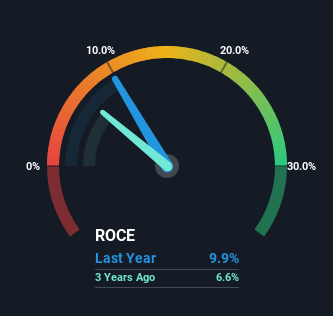
Did you know there are some financial metrics that can provide clues of a potential multi-bagger? Ideally, a business will show two trends; firstly a growing return on capital employed (ROCE) and secondly, an increasing amount of capital employed. Basically this means that a company has profitable initiatives that it can continue to reinvest in, which is a trait of a compounding machine. Having said that, from a first glance at Trusco Nakayama (TSE:9830) we aren't jumping out of our chairs at how returns are trending, but let's have a deeper look.
Return On Capital Employed (ROCE): What Is It?
For those who don't know, ROCE is a measure of a company's yearly pre-tax profit (its return), relative to the capital employed in the business. Analysts use this formula to calculate it for Trusco Nakayama:
Return on Capital Employed = Earnings Before Interest and Tax (EBIT) ÷ (Total Assets - Current Liabilities)
0.099 = JP¥19b ÷ (JP¥249b - JP¥52b) (Based on the trailing twelve months to March 2024).
Therefore, Trusco Nakayama has an ROCE of 9.9%. On its own that's a low return, but compared to the average of 7.4% generated by the Trade Distributors industry, it's much better.
Check out our latest analysis for Trusco Nakayama

Above you can see how the current ROCE for Trusco Nakayama compares to its prior returns on capital, but there's only so much you can tell from the past. If you'd like, you can check out the forecasts from the analysts covering Trusco Nakayama for free.
How Are Returns Trending?
The returns on capital haven't changed much for Trusco Nakayama in recent years. Over the past five years, ROCE has remained relatively flat at around 9.9% and the business has deployed 37% more capital into its operations. This poor ROCE doesn't inspire confidence right now, and with the increase in capital employed, it's evident that the business isn't deploying the funds into high return investments.
The Key Takeaway
As we've seen above, Trusco Nakayama's returns on capital haven't increased but it is reinvesting in the business. And with the stock having returned a mere 21% in the last five years to shareholders, you could argue that they're aware of these lackluster trends. Therefore, if you're looking for a multi-bagger, we'd propose looking at other options.
Like most companies, Trusco Nakayama does come with some risks, and we've found 1 warning sign that you should be aware of.
While Trusco Nakayama isn't earning the highest return, check out this free list of companies that are earning high returns on equity with solid balance sheets.
If you're looking to trade Trusco Nakayama, open an account with the lowest-cost platform trusted by professionals, Interactive Brokers.
With clients in over 200 countries and territories, and access to 160 markets, IBKR lets you trade stocks, options, futures, forex, bonds and funds from a single integrated account.
Enjoy no hidden fees, no account minimums, and FX conversion rates as low as 0.03%, far better than what most brokers offer.
Sponsored ContentValuation is complex, but we're here to simplify it.
Discover if Trusco Nakayama might be undervalued or overvalued with our detailed analysis, featuring fair value estimates, potential risks, dividends, insider trades, and its financial condition.
Access Free AnalysisHave feedback on this article? Concerned about the content? Get in touch with us directly. Alternatively, email editorial-team (at) simplywallst.com.
This article by Simply Wall St is general in nature. We provide commentary based on historical data and analyst forecasts only using an unbiased methodology and our articles are not intended to be financial advice. It does not constitute a recommendation to buy or sell any stock, and does not take account of your objectives, or your financial situation. We aim to bring you long-term focused analysis driven by fundamental data. Note that our analysis may not factor in the latest price-sensitive company announcements or qualitative material. Simply Wall St has no position in any stocks mentioned.
Have feedback on this article? Concerned about the content? Get in touch with us directly. Alternatively, email editorial-team@simplywallst.com
About TSE:9830
Trusco Nakayama
Engages in the wholesale of machine tools, and other equipment in Japan and internationally.
Solid track record with adequate balance sheet.
Market Insights
Community Narratives



